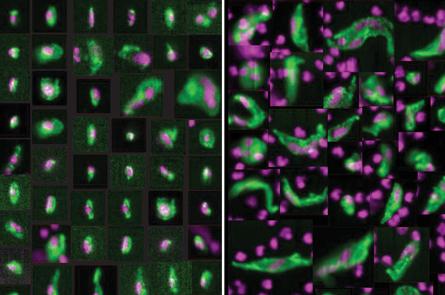ResveratrolConsumer
avert online
consumer fraud
ResveratrolQuiz
test your knowledge
New E-Book
How the world got lost on
the road to an anti-aging pill
Subscribe to our newsletter to receive email notifications when new articles are posted.
March 23, 2012: by Bill Sardi
Worldwide headlines herald a test that may make it possible for cardiologists to predict an impending heart attack. The test may be particularly beneficial for people who have silent (non-painful) heart attacks or heart attacks that cannot be detected by conventional methods.
Compared to healthy adults, four times as many loose cells that slough off the inner lining of arteries, called endothelial cells, were found among heart attack patients who arrived at a hospital emergency room complaining of chest pain. A quicker and more efficient test is now being developed to count circulating endothelial cells in a blood sample.

Endothelial cells (green) found in the bloodstream of healthy people (left) differ from those taken from heart attack patients (right). The cells from heart attack patients tend to cluster and have multiple nuclei (shown in pink). Credit: S. Damani et al/Science Translational Medicine 2012
An association between a rise in the number of circulating endothelial cells and a heart attack actually dates back to the 1970s. Maybe 5 circulating endothelial cells per milliliter of blood can be found in healthy adults. The problem is that the tests to measure a rise in the number of these cells have been limited to experimental studies, not everyday clinical use. An improved test is in development and will be certainly welcomed.
But even with the test, what would be the therapy? You may or may not be surprised at the answer – red wine molecules.
At least that is what researchers in Europe discovered about five years ago. Laboratory animals were subjected to a chemical (carbon tetrachloride) in their drinking water that induces an increase in circulating endothelial cells. Untreated healthy animals only had an average of 2.47 of these cells in their blood sample. Adding the chemical to their water increased the number of circulating endothelial cells by three-fold. Then the animals were given three weeks to recover, but time alone did not produce a decline in the number of these freely roaming cells. Three weeks of recovery plus the provision of red wine molecules significantly decreased their numbers in the blood (from 6.88 to 4.61 cells per milliliter).
Red wine molecules not only were effective after administering the chemical but also preventively, when given in drinking water prior to the caustic drug. The effect was more dramatic when given prior to the chemical.
Red wine pills are widely available in health food stores. Resveratrol is the best-studied red wine molecule, but it is not the only protective molecule in wine. Red wine pills that provide an array of protective molecules are more likely to produce the same protective effect seen in laboratory animals.
Posted in Resveratrol
Add comments »